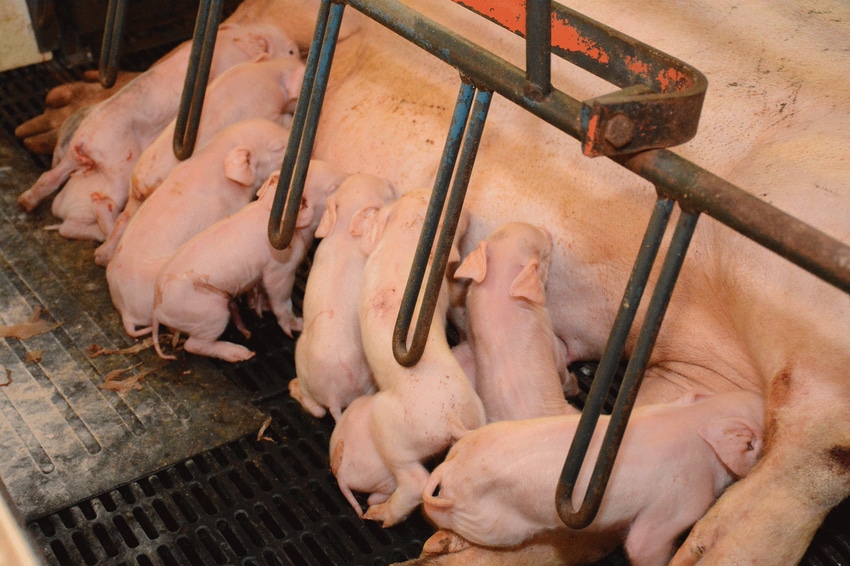The Maschhoffs has prioritized improvement over herd growth. As a result, The Maschhoffs, based in Carlyle, Ill., has decreased the company’s sow base from 218,000 sows last year to 215,000 this year.
June 7, 2018

Prompted by the opening of new pork processing plants, the U.S. swine industry is expanding, barns are being built all over the countryside, and everyone is adding sows to the American swine herd.
But not everyone is expanding their sow herd. The Maschhoffs has prioritized improvement over herd growth. As a result, The Maschhoffs, based in Carlyle, Ill., has decreased the company’s sow base from 218,000 sows last year to 215,000 this year.
Josh Flint, associate director of communications, says, “You look across the industry, and everyone is expanding. In anticipation of the massive increase in packer capacity, everybody went out and put barns up.”
While the industry was in expansion mode, The Maschhoffs has been focused on improving efficiency. “We made a strategic decision to zero in on becoming a best-cost producer, and at the same time did not prioritize growth as part of that strategy,” Flint says. “As the U.S. meat industry works through potential market access challenges, we feel this strategy will best position us for the future.”
Efficiency rules
Becoming more efficient is what hog production is all about, and Bradley Wolter, president of The Maschhoffs, says the company is doing just that. “From our outlook, we’re looking at similar production with a much smaller sow base.”
Cutting back on sow numbers wasn’t necessarily a part of The Maschhoffs grand plan. “Our grand plan was to be the industry’s high-value, cost-efficient hog supplier, and that led us to a similar level of output — a 5 million pig production system, but we’re doing it with fewer sows,” he says. “That’s been one of the best decisions for us up to this point.”
The Maschhoffs had been growing by leaps and bounds for the last 20 years. But with that growth, Wolter says, one thing has not wavered: “We have always been about return on equity. It’s about return on equity to our stakeholders, not only our family owners, but also equally important, that means our family partners in terms of our contract grower base. We are committed to ensuring we deliver a steady return back to rural America for generations to come. This strategy allows us to consistently deliver against that purpose.”
Wolter says, “We took a look at our portfolio of farms after a decade-long growth spurt where we acquired everything and relinquished absolutely nothing, and we looked at our operating footprint and said how we can become better at what we do.”
Though the company is still a hog production giant, Wolter says the decision has been made to continue to invest, “but in a very different definition than what we would have done prior. We’re investing to live up to that vision and strategy of becoming the most cost-efficient, high-value hog supplier. That’s our guiding principal: We want to be the high-value, cost-efficient hog supplier to U.S. packers and processors, which enables us to ensure we’re making sustainable investments in the rural communities where we raise pigs.”
Wolter says the management team wakes every day “trying to be the high-value, cost-efficient hog supplier in the U.S., and that has been our position since 2015, and we’ve been focused on that, and we’ve organized ourselves in such a way to do that.”
To accomplish this task, Wolter says it’s not enough to produce pork at the lowest cost. “We recognize in a commodity industry that cost is relevant, but that said, it’s relevant in value-added,” he says. “We focus on value, and we do that in context of the customer experience. It’s a pull-through system; we don’t produce a product the customer doesn’t demand. And so that’s our vision; that’s what guides our decision-making.”
Re-examining the company’s place in the industry and its mission forward, Wolter says there was a self-examination of sorts, which resulted in the adoption of a regional model for the company (see related article).
“Because we thought that it would allow us to get there [low cost, high value] more quickly, and I believe that it has,” he says. “The fact that we’re fewer in terms of our sow numbers implies that we felt that we needed to reoptimize our resource base, which is what we’ve done. Throughout that process, we took a look at some of the farms that weren’t the best fit for our operational footprint in terms of transportation costs. In these situations, the farms have moved to other U.S. hog producers, where they continue to be productive.”
As the company’s footprint kept growing, management saw the need to recalibrate … and get back to the core strategy of cost-effective, yet innovative, hog production with a strong focus on customer service. “And that’s what we’ve done,” Wolter says. We’ve seen those returns come back, and we’re optimistic and very bullish on where we’re at and where we’re going from here. It’s a vision and strategy that has served well up to this point.”
The Maschhoffs’ decision to reduce its herd does not mean it’s standing pat, comfortable with its place in the industry. Investing continues, as Flint references its recently completed 2,500-sow Bear Grove genetic nucleus farm in southern Illinois.
“The Maschhoff family continues to invest in the business with the primary goal being long-term success,” he says. “This lines up with the strategy of best-cost, innovative hog production, while continuing to deliver top-notch customer service. Again, the common theme is improvement over growth.”
You May Also Like



